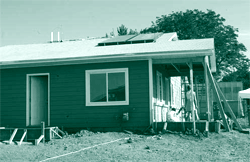November 2008
In this Issue
Resources Mitigate the Impact of Major Disasters
Rising Housing Costs 1985 – 2005: A Closer Look
Housing and Economic Recovery Act of 2008 Boosts Energy-Efficient Mortgages
Riding For Affordable Housing
In the next issue of ResearchWorks
Housing and Economic Recovery Act of 2008 Boosts Energy-Efficient Mortgages
The amount of energy used by the average American household has doubled since 1980 and is expected to continue rising, according to the U.S. Department of Energy's (DOE's) Energy Information Administration. Much of this increase is attributable to the growing number of electrical products and appliances found in our homes. This increased usage coincides with a dramatic rise in the cost of energy. DOE reports that the average American household consumes 10,656 kilowatt-hours (kWh) of electricity per year. An energy-efficient home can lower those bills 10 to 50 percent, depending on the energy improvements performed and prevailing local climatic conditions.

The Housing and Economic Recovery Act of 2008 (HERA), which primarily seeks to address the current mortgage and housing crisis in the United States, also includes measures to encourage greater use of energy-efficient mortgages (EEMs). Although EEMs (also known as green mortgages) have been available since the early 1990s, the Federal Housing Administration (FHA) has typically issued only about 30,000 EEMs annually.
Section 2123 of HERA increases the limits for cost-effective energy-efficiency improvements to nearly 5 percent of the property value; the current cap is $8,000. The section does limit the number of EEMs to 5 percent of the aggregate number of mortgages for 1- to 4-unit family residences insured by HUD during the preceding fiscal year. Section 2902 requires the Secretary of Housing and Urban Development to develop recommendations to eliminate barriers to the use of energy-efficient mortgages, which must be submitted to Congress. These barriers include:
- A lack of reliable and accessible information about EEMs;
- Confusion about underwriting requirements and differences among various EEM programs;
- The complexity and time involved in securing a green mortgage;
- A lack of publicly available research on the default risk of such mortgages; and
- The availability of certified or accredited home energy rating services.
HUD is also tasked with developing an outreach/education campaign to inform consumers, homebuilders, residential lenders, and other real estate professionals about EEMS, as well as the availability, benefits, and advantages of improved energy efficiency in housing.
How It Works
EEMs are available to buy a new energy-efficient home, upgrade an existing home, or refinance an existing FHA loan. Borrowers can fold the cost of energy-efficiency upgrades — which could include insulation, high-efficiency appliances and furnaces, replacement windows, solar hot water heaters, and more — into the total mortgage. Highly efficient upgrades will save more money through reduced energy demand than they cost to install. Choosing an energy-efficient mortgage allows homebuyers to spend more on other expenses and less on energy costs.
Eligible properties include new and existing homes with 1 to 4 units. Under Section 203(b) of the National Housing Act, borrowers can finance up to 97 percent of the cost and may fold closing costs and a mortgage insurance premium into the total mortgage. An energy-efficient mortgage eliminates the need for borrowers to get a separate loan for energy improvements when buying a home. The interest on mortgage payments is tax deductible, which can save owners more money than would paying for energy upgrades with a credit card or bank loan.
Home Energy Rating Systems (HERS)
The first step toward getting an EEM is securing a home energy rating. This rating, performed by a home energy rating systems (HERS) or energy consultant, will determine the cost of energy improvements and estimate the energy savings that will result from those upgrades. A portion of the cost of the energy rating can be folded into the mortgage cost as well. The inspector evaluates a home’s energy efficiency by examining factors such as insulation, appliances, air infiltration, windows, local climate, and utility rates. This evaluation is documented in a written report that includes:
- An overall energy rating score of the house in its current condition;
- Suggested cost-effective energy upgrades;
- Estimates of the costs, annual savings, and useful life of any upgrades;
- An improved energy rating score after installation of the recommended upgrades; and
- An estimated total annual energy cost for the home before and after upgrades
The total improvement cost must be less than the total present value of energy that's expected to be saved over the life of the energy upgrade. Energy improvements/upgrades are installed after closing. The lender places money in an escrow account that releases funds to the borrower after an inspector verifies that the improvements have been made and will achieve the projected energy savings.
The cost of eligible energy-efficient upgrades is added to the mortgage total, which can exceed the loan mortgage amount by the sum of the energy upgrade costs. The maximum amount for a single-family unit depends on its location. FHA mortgage limits, adjusted annually for any U.S. county, can be found at https://entp.hud.gov/idapp/html/hicostlook.cfm.
More information about HUD's energy-efficient mortgage program can be found at www.hud.gov/offices/hsg/sfh/eem/eem_prog.cfm. The full text of the Housing and Economic Recovery Act of 2008 can be downloaded at http://frwebgate.access.gpo.gov/cgi-bin/getdoc.cgi?dbname=110_cong_bills&docid=f:h3221enr.txt.pdf.

